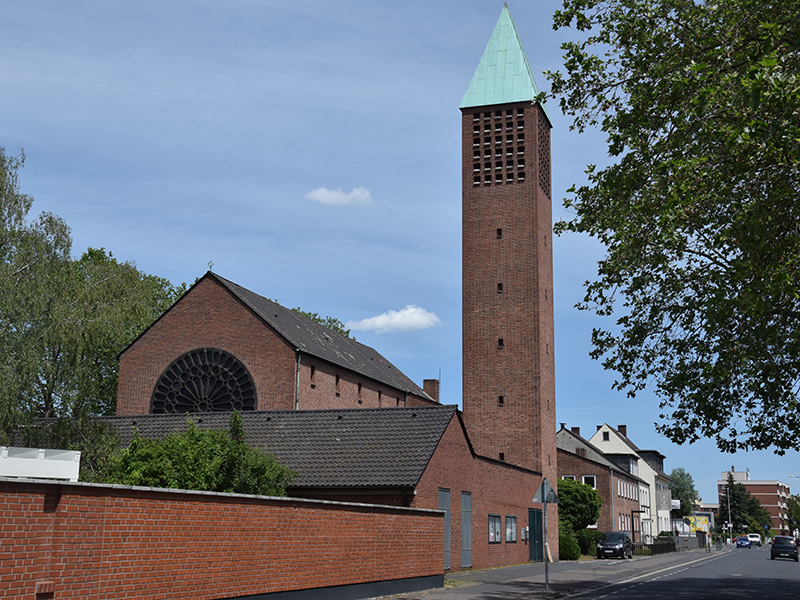13. Projekte Tour: St. Paulus Kirche
HISTORISCHE INFORMATIONEN ZUR St. PAULUS KIRCHE
Auf dieser Seite erhalten Sie weiterführende Informationen zur St. Paulus Kirche vom Denkmal- und Geschichtsverein Bonn-Rechtsrheinisch e.V.
St. Paulus Kirche
Als 1868 die Rheinische Jutespinnerei in Beuel ihren Betrieb aufnahm, dehnte sich der Ort immer weiter nach Osten aus. Viele Ausländer, besonders Italiener, siedelten an dieser Stelle an, die durch die Bahnlinie vom alten Beuel getrennt wurde. Die Gläubigen wurden von St. Peter Vilich betreut, später dann, ab 1924, von St. Josef Beuel.
1902 richteten sich die Franziskanerinnen in den Räumen der ehemaligen Jutespinnerei einen Kindergarten ein. Ein Raum in der Fabrik wurde für den Gottesdienst hergerichtet, der hier dann regelmäßig gehalten wurde. Die Priester kamen von St. Josef Beuel herüber.
Am 19.03.1957 wurde der erste Spatenstich für die neue Kirche getan, die von dem bekannten Kölner Architekten Dominikus Böhm entworfen worden war; die Ausführung übernahm sein Sohn Gottfried.
Im Juni 1958 war es dann soweit, die Pfarre wurde gegründet und die erste Heilige Messe fand am 7. September 1958 statt. Nun wurden auch noch ein Kindergarten, ein Pfarrsaal und eine Bücherei gebaut. Am 1. Januar 2001 ist St. Paulus mit St. Josef in Beuel fusioniert zu ‚St. Josef und Paulus‘. St. Paulus war bis 2005 Heimat der spanisch sprechenden Gemeinde.
Leider kann seit dem Christkönigfest des Jahres 2008 in der vor 53 Jahren geweihten Kirche nicht mehr regelmäßig Sonntagsgottesdienst gefeiert werden.
Immerhin wird seitdem mit dem Seniorenkreis am jeweils ersten Montag im Monat um 14.30 Uhr eine heilige Messe gefeiert. An jedem Mittwoch versammelt sich um 18 Uhr eine Beterschar zum Abendgebet.
Die Pfarrgemeinde St. Josef und Paulus möchte die Pauluskirche erhalten. Deshalb wird unter dem Titel „Forum Pauluskirche“ mit Veranstaltungen aller Art, Vorträgen und Konzerten, ein Ort des Gebets, des Gesprächs und der Diskussion angeboten. Dies kann nur gelingen, wenn Interessenten aus dem Stadtgebiet Beuel und ganz Bonn den Weg in dieses vom berühmten Kirchenbaumeister Gottfried Böhm gebaute Gotteshaus finden.
Architektur
St. Paulus erscheint als blockhaft geschlossener Bau, den nur wenige Einzelformen auflockern: Die Rechteckfenster unter der Dachtraufe, die Fenster der Vorhalle und im Seitenschiff sowie die Fensterrose an der Südseite. Die Rosette ist ein Stilelement gotischer Architektur.
Der Saal der Kirche wird von einer leicht gewölbten Kassettendecke überspannt. Seitlich öffnet sich das Mittelschiff in voller Länge zum niedrigeren Seitenschiff. Charakteristisch ist der bühnenartig erhöhte Chor, die einseitige Belichtung des Altarraumes durch ein hohes Fenster und die großen ungegliederten Wandflächen.
Ausstattung
Der Taufstein steht vor der Kanzel im Kirchenschiff und im Seitenschiff befindet sich ein Marienaltar. Die Glasfenster in der Vorhalle und im Seitenschiff stellen nach Entwürfen des Architekten Heilige dar. 1998 wurde die von Walter Prinz aus Köln geschaffene Terrakottaskulptur des Gekreuzigten an der Altarwand aufgestellt.
Glocken
Im Turm hängen drei Glocken.
| Nr. | Name | Gussjahr | Gießer | Durchmesser (mm) |
Masse (kg) |
Schlagton (HT-1/16) |
| 1 | Paulus | 1958 | Glockengießerei Mabilon, Saarburg | 980 | 580 | as1 –4 |
| 2 | Maria | 1958 | Glockengießerei Mabilon, Saarburg | 880 | 400 | b1 –4 |
| 3 | Adelheid | 1958 | Glockengießerei Mabilon, Saarburg | 740 | 240 | des2 –4 |
Orgel
Im Jahre 1960 erhielt St. Paulus eine zweimanualige Orgel mit 22 Registern auf elektrischen Schleifladen. Sie wurde von der Orgelbaufirma Ernst Seifert aus Bergisch Gladbach gebaut. Der Einbau von drei weiteren Registern war vorbereitet. Das Instrument wurde 1998 abgebaut und das Pfeifenmaterial von der Firma Merten im Jahr 2000 in einem technischen Neubau in der Kathedrale von Taschkent (Usbekistan) wiederverwendet.
Die heutige Orgel stammt von der Firma Verschueren (Niederlande). Diese Orgel wurde ursprünglich 1966 als Opus 665 für die Pfarrkirche St. Petrus Canisius in Düsseldorf-Unterbilk (profaniert 1998, abgerissen 1999) gebaut. Das Instrument verfügt über mechanische Schleifladen mit elektrischer Registertraktur.
Quelle: Dechant Dr. Wilfried Evertz, Diakon Klaus Behne, Wikipedia
